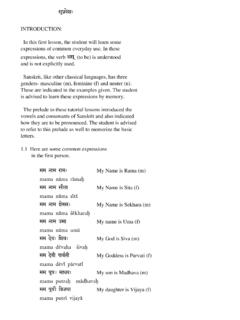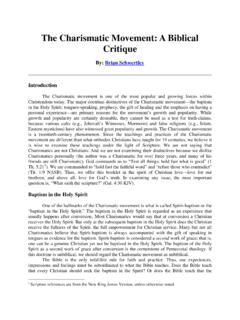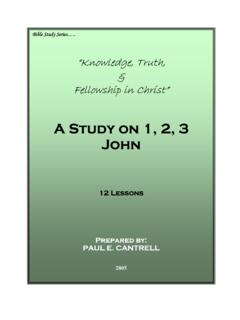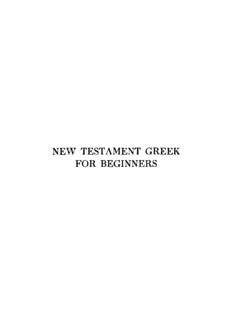Transcription of Lesson-10 In Sanskrit, verbs are associated with ten different
1 Lesson-10 General introduction to the sanskrit , verbs are associated with ten differentforms of usage. Of these six relate to the tenses andfour relate to moods. We shall examine the tenses are identified as follows. The tensesdirectly relate to the time associated with the activity specified in the verb , , whether theactivity referred to in the verb is takingplace now or has it happened already or if itwill happen or going to happen tense: vtIman kal:There is only one form for the present tense:B t kal:Past tense has three forms associated with Expressing something that had happened sometime in the recent past, typically last few Expressing something that might have just happened, typically in the earlier part of the Expressing something that had happened in the distant past about which we may not have much or any tense:B v yt- kal:Future tense has two forms associated with Expressing something that is certainly going to Expressing something that is likely to forms not associated with are four forms of the verb which do not relateto any time.
2 These forms are called "moods" in theEnglish language. English grammar specifies threemoods which are, Indicative mood, Imperative moodand the Subjunctive mood. in sanskrit primers onesees a reference to four moods with a slightlydifferent nomenclature. These are, Imperative mood,potential mood, conditional mood and benedictive mood. Since the nomenclature differs we will haveto see what the moods in sanskrit actually refer ten forms of usage of the verb are each given aname in sanskrit and all the names start with theakshara l. Hence the forms are called the ten "lakaras"(Even though two of the forms do not strictly start with l , the term lkara: applies) tense - HqPast tense - aorist4. lzqPast tense - zqFuture tense - zqFuture tense - HqConditional mood8. v D lHq Potential lIHq Benedictive moodIt may be noted that five of the lakaras end in zq andthe remaining five in Hq . One more Lakara is known tobe seen in Vedic texts.
3 It is known as lEzq .It must also be remembered that verbs in sanskrit belongto two categories depending on whether the activityspecified in the verb applies to the person himselfor whether it applies to someone other than the subjectof the referring to the activity for the self are said to be"Atmanepada" Aa mnEpd referring to the activity for others are said to be"Parasmaipada" pr mWpd which can take both forms are known as "Ubhayapada" uBypd verb in sanskrit can be traced to a root which wemay refer to as the root form of the verb . There are manyinstances of verbs being derived from two different formsof a root. The form of the root used in deriving the verbwill depend on the of the verb for the different tenses and moods areobtained by adding suffixes or prefixes or both to theroot form and adding an infix as well. So we may saythat the general for of any "lakara" is (prefix) + root form + infix + suffixThe paranthesis indicates that the prefix is not presentin all the infix is generally referred to as the conjugational form of the infix is dependent on the root form aswell as person.
4 in sanskrit , the aksharas in the infix aretermed as vkrNp# yy: and those in the suffix are called tHqp# yy: . The root form is known as Dat .The suffix is referred to as the verbal termination form of the suffix depends on the lakara and we canapply some rules to arrive at the suffixes. For each ofthe lakaras, nine suffixes will have to be persons and three numbers for each person makeup the may be borne in mind that the verbal termination signsalso depend on the type of the verb , , "Atmanepada"or "Parasmaipada".We have seen in lesson 3 the conjugations of the verb inthe present tense. Later in this lesson we shall study the conjugations for the other tenses and moods. These willbe covered in independent Lesson10 Past tense (simple past tense):The form considered here is lHqAs seen in the introduction, the formation ofthe verb may be specified through a formula.
5 (prefix) + verb root + infix + suffix The infix is based on the root and the personwhile the suffix, referred to as the verb termination, depends on the tense or the the simple past tense, A is the terminations are as follows. These apply for verbs in "parasmaipada". | t| |vmApplying the formula the forms of a verb will beobtained asIII +vr+A+t-III DualA+vr+A+tam-III +vr +A+An-II +vr+A+s II DualA+vr+A+tm-II Pl. A+vr+A+tI +vr+Aa+A|I DualA+vr+Aa+vI Pl. A+vr+Aa+mNow for the forms (past tense) of the verb g C root form for the verb is g CqThe infix corresponding to the root g C qqqis also Afor second and third person but Aa for first Ct-Ag Cta|Ag Cn-He wentThey twoThey C:Ag Ct|Ag CtYou wentYou twoYou C|Ag CavAg CamI wentWe twoWe wentwentThe discerning reader would want to know why inthe case of the second person singular, there isno conformity with the indicated termination s orwhy differences are seen in applying Sandhi rules?
6 It must be remembered that there are specific grammar rules in repect of how sounds are modified when suffixesare added. Typically, the suffix s ,when added to a nounor verb root, becomes a visarg. We will not dwell on thismuch, as this is beyond the scope of our current Lesson 10 Future Tense- B v y kal:As seen in the introduction, Future Tense may express something that is certainly going to happen(l zq) or express something that may happen(l zq).Of these two, l zq is seen in frequent infix for future tense is y. This infix changes itsform to i y when applied to some roots. In some casesit may become y. There is no direct rule or formulawhich we can remember in respect of this infix. Itwill be necessary to commit to memeory the formsfor different many verbs , two root forms may be seen. Forexample, gm- , g Cq are the two root forms given for g C , pa , pb- for pb t and Ta , t q for t t.
7 The form of the verb for future tense will be basedon the first root where two roots are seen earlier, the second form of the root will beused in generating the verb in present tense, past tenseand imperative mood. Let us look at the terminations for future infix and the tense terminations are combinedtogether and shown table applies to verbs in "parasmaipada" y t yt: y tII y s yT: yTI ya m yav: yam:Now for the forms of the verb g C t in future m y tg m yt:g m y tHe will They twoTheygowill gowill goIIg m y sg m yT:g m yTYou willYou twoYougowill gowill goIg m ya mg m yav:g m yam:I will goWe twoWe willwill gogoThe forms for pb t. Please note that the formof the root that is taken is pa .IIIpa y tpa yt:pa y tHe willThey twoThey willdrinkwill drinkdrinkIIpa y spa yT:pa yTYou will You (two)You willdrinkwill drinkdrinkIpa ya mpa yav:pa yam:I willWe (two)We willdrinkwill drinkdrinkThe student would have observed by now that he/shewill have to remember the root forms for many verbsto be able to correctly form the verbs .
8 Panini, theforemost among Grammarians, had listed about 1950root forms for sanskrit . Surprisingly, knowledge ofjust about 300 of the root forms will be adequate forunderstanding sanskrit you arew curious as to what these 300 are, you mayhave to wait for advanced lessons to be put up in thesepages! This is a big task and we would like to know ifyou are interested. Send us a Lesson 10 Summary of root terminations and verbal terminations for different tenses and tables given below may be used as a basicreference for determining the forms of the verbsin different tenses. The student is reminded thatthe table is given only as a reference and theterminations cannot be blindly applied to a rootform. It will be necessary to remember the rootforms for many for the present Tensepr mWpdAa mnEpdIII t t: A ttE itE A tEII s T: TsE iTE vEI m v: m:i vhE mhETerminations for the Past (imperfect) tenseIIIt- tam- An-t ita| A tIIs tm- tTa: iTa| vm-IAm- v mi v h m hTerminations for the Future TenseIII y t yt: y t ytE yEtE y tEII y s yT: yT ysE yTE y vEI ya m yav: yam: yE yavhE yamhEIn case of the Future Tense, we have already seenthat the general termination is y.
9 In some verbs , y changes to y and also takes i in the beginningof the termination. The form shown above may beinterpreted in the light of this for the Imperative MoodIIIt ta| A t ta| ita| A ta|IItat- t| t v iTa| vm-IAa n Aav Aam-eE AavhW AamhWTerminations for the Potential MoodIIIiIt- iItam- iIy :iIt iIyata| iIrn-IIiI: iItm- iItiITa: iIyaTa| iI v|IiIy| iIv iImiIy iIv h iIm h







